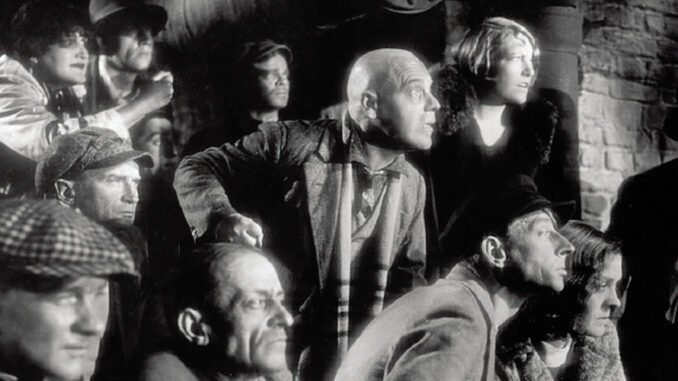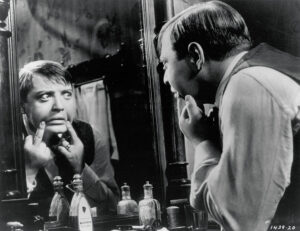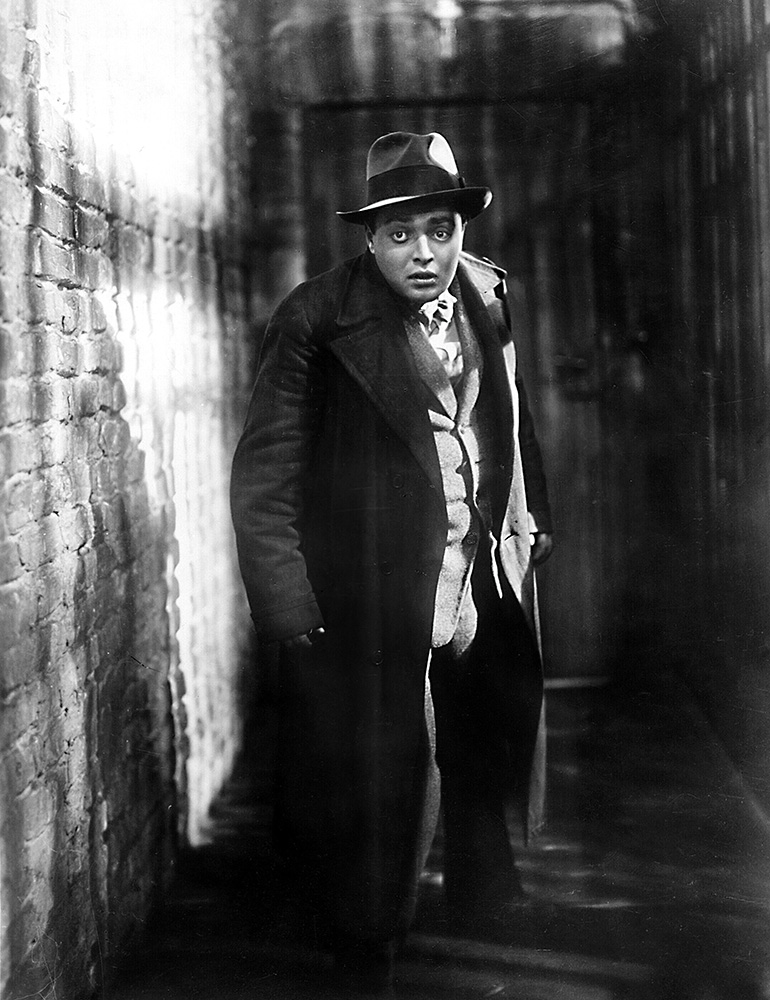
by Edward Landler
From a black screen, a circle of children fades in and the little girl at its center sings a counting out song:
Just you wait it won’t be long
The man in black will soon be here
With his cleaver’s blade so true
He’ll make mincemeat out…of…you.
These words, in German, are the first spoken in Fritz Lang’s M, as it premiered 85 years ago in Berlin on May 11, 1931. Depicting the hunt for a fictional serial child-killer, the movie was an immediate success in Germany and its initial distribution in Europe brought it almost universal acclaim as a classic.
German audiences were familiar with the child’s song, a popular rhyme about a real serial killer, Fritz Haarman, known as the Butcher of Hanover, convicted and executed in 1925. Three weeks before M opened, yet another, Peter Kürten, called the Düsseldorf Monster, was convicted on nine counts of murder and seven counts of attempted murder; he was beheaded on July 2, 1931.

Directed by Fritz Lang
Shown: Peter Lorre
The most prominent director in the German industry at the time, the Austrian Lang was attacked for capitalizing on these lurid crimes. The movie, however, transcends its sensational subject matter to offer a perspective on the loss of individuality in an urban mass society and the lure of authoritarian rule that still casts shadows on human society.
Adding to the film’s power, director Lang — with editor Paul Falkenberg — built on the visual expressionism of German silent films to create expressionistic audio material that expanded the movies’ means to portray a character’s emotional reality.
Lang’s work over the previous eight years — including the two-part medieval epic The Nibelungen (1924) and the futuristic Metropolis (1927) — had been produced by Germany’s largest film company, Ufa. By 1930, however, their association had become contentious. The director felt the studio had not adequately prepared for the coming of sound and, for his first sound film, he entered into an agreement with producer Seymour Nebenzahl of Nero-Film.
Nebenzahl had already produced G.W. Pabst’s adaptation of Frank Wedekind’s Pandora’s Box (1929) and Robert Siodmak’s People on Sunday (1930), written by Billy Wilder. Like Lang, some of Sunday’s creative team wound up working in Hollywood after Adolf Hitler came to power.
In a 1963 interview, Lang recalled, “I told the producer, ‘I can make whatever I please and you have nothing to say, except to give me the money…’ and he accepted this.” As for the story, Lang turned to Thea von Harbou, his wife and writing collaborator.
He asked her, “What is the most despicable crime you can imagine?” and they began to turn out a screenplay about poison pen letters. But, on May 24, 1930, Kürten was captured by the police.
Intrigued by the newspaper reports, the director shifted the script’s focus to a sexual deviant who kills children. The things that concerned him were, Lang said, “what drives a man to such a horrible crime and laying out the pros and cons of capital punishment.”
The filmmaker was further aroused by how the intense police investigation of Kürten’s crimes disrupted Düsseldorf’s “normal” criminal activity. The heightened surveillance imposed by the police led to gang alliances with the city’s beggars to help track down the psychopathic killer.
This theme of the common civic goals of legal authority and the underworld first emerged on stage in Bertolt Brecht and Kurt Weill’s The Threepenny Opera in 1928. Nebenzahl and Nero-Film also produced Pabst’s 1931 film version of the musical play just before M went into production. Asked in 1963 if Brecht had influenced him, Lang said, “Of course… Which of his contemporaries did he not influence?”
Determined to achieve authenticity in his film, Lang toured prisons, and explored Berlin to find the beggars’ social network. He spent eight days in a mental institution observing sex offenders, and interviewed psychiatrists about the mental states of compulsives. This experience, he later said, “convinced me of the injustice of the death penalty.”
Lang’s research also took him to Berlin’s Alexanderplatz police headquarters and London’s Scotland Yard for an intensive review of police procedures. He based M’s homicide detective, “Fatty” Lohmann, on the famed director of the Berlin Homicide Division, Ernst “Fatty” Gennat, who had been asked by the Düsseldorf police to work on the Kürten case.

Directed by Fritz Lang
Shown: Peter Lorre
At the American Film Institute in 1973, Lang claimed credit for writing Lohmann’s and the police officials’ dialogue. Von Harbou, he said, was responsible for most of the rest of the dialogue, including the serial killer’s gripping confessional speech in the criminals’ kangaroo court.
Wishing to cast the psychopath against the stereotype of the era, Lang said, “I used Peter Lorre, who nobody would think to be a murderer.” The movie’s success made the Hungarian actor an international star.
Born Laszlo Löwenstein, Lorre came to Berlin in 1928 to join the avant-garde People’s Theater, founded by Socialists in 1899 and subsidized by labor unions. This short, pudgy, bulging-eyed performer conveyed an emotional intensity in a variety of roles for the theatre — an exotic gangster in Brecht and Weill’s Happy End (1929), a teenager alarmed by his puberty in Wedekind’s Spring’s Awakening (1929) and a sexist soldier in Pioneers in Ingolstadt (1928), an early feminist comedy.
Appropriately, Lang offered Lorre the role of Hans Beckert while he was rehearsing for Brecht’s A Man’s a Man (1931), in which he played a meek porter transformed into a ruthless killer after being recruited into the army. Every day during production of M, the actor returned to the theatre after the shoot to rehearse Brecht’s play and to appear in a Soviet farce about a Moscow housing shortage.
For three days after filming the kangaroo court scene, however, the actor could not appear on stage. Years later, in an account of the production, Falkenberg wrote, “Lang beat a performance out of Lorre in the film’s finale…past the limits of physical endurance.” The director ordered numerous takes of the actor being kicked in the shins with nailed boots and being thrown down concrete stairs into a wood pile, as vividly shown in the film.
Among other People’s Theater actors cast for M was Otto Wernicke, the admired “actor of the people” who played Inspector Lohmann. From Max Reinhardt’s Deutsches Theater, Gustaf Gründgens brought a sophisticated air to the role of Schränker, the criminal leader. This actor later became a Nazi and was the director of the Prussian State Theatre under the Third Reich; the central character of István Szabó’s Oscar-winning Mephisto (1981) was based on Gründgens.
Adding to the film’s power, director Fritz Lang — with editor Paul Falkenberg — built on the visual expressionism of German silent films to create expressionistic audio material that expanded the movies’ means to portray a character’s emotional reality.
For extras, Lang hired professional criminals he had come across in his research; many of them can be seen among the crooks in the kangaroo court, filmed on location in an abandoned schnapps factory. While shooting this scene close to production’s end, word got out that the police planned to raid the set. The director managed to persuade his “jurors” to stay long enough for him to get the shots he needed before the police arrived. There had already been a high rate of turnover — 24 extras were arrested over the course of production.
The bulk of the shooting took place in a zeppelin hangar converted into a film studio outside Berlin. In 1965, Lang told Peter Bogdanovich that he had shot there before, but when he went to arrange for M — originally titled Murderer Among Us — the manager refused to rent the facility. He told Lang the picture shouldn’t be made because it would hurt many “who will become very important.” When the filmmaker asked “why a movie about a child murderer should hurt anybody,” the manager’s attitude changed and Lang got his lease.
Lang noticed a swastika button pinned under the manager’s lapel and realized the man had assumed from the title that the film would slur the Nazis. The director decided to rename the film. While shooting, and struck by the strong visual imagery of the white chalk ‘M’ impressed from a crook’s palm onto the back of the killer’s coat, Lang found his title.
The screenplay had been completed in November 1930 and the six-week shooting schedule extended from mid-December 1930 through early February 1931. Fresh from The Threepenny Opera, director of photography Fritz Arno Wagner and sound recordist Adolf Jensen went straight into production on M. Wagner had also shot Destiny (1921) and Spies (1928) for Lang.
Their collaboration produced the first full exposition of the style and techniques that became film noir. The shooting integrated documentary-style naturalism with dramatically lit expressionism. Complementing this, the audio emphasized specific street sounds over others to reflect the focus of a character’s attention. A key example is the absence of a score and the use of source music.
The only music in the movie were the tunes of street organ grinders and Beckert whistling Grieg’s “In the Hall of the Mountain King” whenever his impulses overwhelmed him. Lorre was unable to whistle the melody, so the strains of Lang whistling are heard in the picture.

Directed by Fritz Lang
Shown: Inge Landgut
The crew worked from a detailed shooting script with elaborate notes on set design, lighting and editing. During the pre-production planning that produced the shooting script, Lang and editor Falkenberg invented the use of voiceovers, pre-lapping and post-lapping. These innovations, the director said, “not only accelerated the tempo of the film but strengthened the necessary association in thought for two juxtaposed scenes.”
The producer booked the May 11 opening for M before shooting wrapped, allowing barely 10 weeks for post-production, but the meticulous pre-production planning facilitated the editing.
A few days before the premiere, sitting with von Harbou and Nebenzahl in the office of the State Film Examiner, Lang recalled feeling “like a school child waiting for approval.” The censors’ verdict: “This film shows everything which we are opposed to showing in a picture, but it is done with such honesty and integrity that we don’t want to make a cut.”
M was released in Germany at 117 minutes. For exhibition in the US, the Production Code Administration required the deletion of all indications of the murderer’s sexual pathology and a 92-minute version of the film opened in New York on April 2, 1933.
After the Berlin premiere, a leading Protestant gazette editorialized that Lang had “very skillfully avoided taking a decided stand on the death penalty.” On May 21, 1931, reading his own views into M, Joseph Goebbels (later Hitler’s Minister of Propaganda) wrote in his diary, “Fantastic! Against humanitarian sentiment. For the death penalty! Well made. One day, Lang will be our director.”
With the 1933 instatement of the Third Reich, Goebbels made overtures to Lang about making Nazi films. The liberal director, whose mother was Jewish, left Germany to carve out a career in Hollywood. The Jewish Lorre also fled to America, stopping over in England to play an assassin in Alfred Hitchcock’s 1934 movie The Man Who Knew Too Much. Von Harbou divorced Lang, became a Nazi and continued to be a leading figure in the German film industry.
Goebbels banned M, as well as Lang’s last film before his departure, The Testament of Dr. Mabuse (1933), which premiered in Paris. In this film, M’s Inspector Lohmann contends with a criminal genius imprisoned in an insane asylum hatching plans to take over Germany — plans that writers Lang and von Harbou (before their divorce) virtually copied from Hitler’s writings.
In 1951, against Lang’s wishes, Nebenzal (now spelling his name without the ‘h’) produced an American remake of M, directed by Joseph Losey. Despite its Los Angeles location photography and surface fidelity, it cannot capture the original’s social authenticity, making its points with didactic dialogue rather than visual drama.
The last word on M remains Lang’s. Commenting on the film’s last line, he said in 1963, “The point of the film is not the conviction of the murderer but the warning to mothers, ‘One has to keep closer watch over the children… All of you!’” He added, ironically perhaps, “This human accent was especially important to my wife at that time, the writer Thea von Harbou.”






